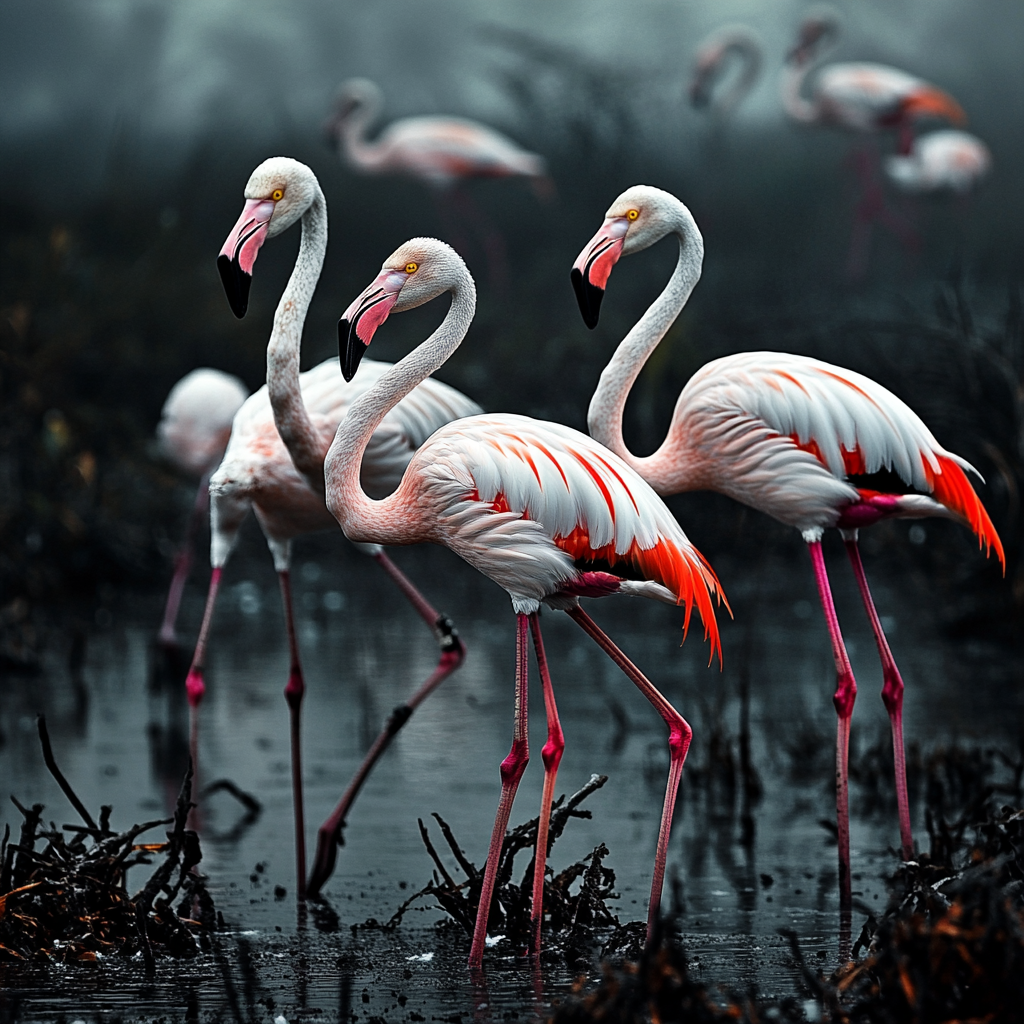
Top 10 Interesting Facts About Flamingos
Share
Flamingos are among the most recognizable and fascinating birds in the world, known for their striking pink plumage and unique feeding habits. These social wading birds are found in various parts of the world, particularly in tropical and subtropical regions. This blog post explores ten interesting facts about flamingos, drawing from authoritative sources to provide a comprehensive understanding of these remarkable creatures.
1. Flamingos Get Their Color from Their Diet
One of the most striking features of flamingos is their vibrant pink color. However, flamingos are not born pink; they hatch with gray feathers. The pink coloration comes from their diet, which is rich in carotenoids—pigments found in algae, brine flies, and shrimp. When flamingos consume these foods, their bodies metabolize the carotenoids, which then deposit in their feathers, skin, and even beaks. The more carotenoids they consume, the pinker they become. In fact, if flamingos do not eat enough carotenoid-rich foods, their feathers can fade to a whitish color .
2. Flamingos Are Filter Feeders
Flamingos have a unique feeding mechanism that allows them to filter small organisms from the water. They are known as filter feeders, using their specialized beaks to strain food from the water. When feeding, a flamingo dips its head upside down into the water and uses its tongue to pump water in and out of its bill. The bill has comb-like structures called lamellae that trap small food particles such as algae, crustaceans, and tiny seeds while allowing excess water to flow out . This feeding strategy is essential for their survival, as it enables them to access nutrient-rich food sources in shallow waters.
3. Flamingos Can Sleep Standing on One Leg
Flamingos are known for their ability to sleep while standing on one leg. This behavior is not just a quirky trait; it serves several purposes. Standing on one leg helps flamingos conserve body heat by reducing heat loss through their legs and feet. By tucking one leg close to their bodies, they minimize exposure to cooler air or water temperatures . Research has shown that flamingos use less muscle power when standing on one leg compared to two legs, making it a more energy-efficient position for resting.
4. A Group of Flamingos Is Called a "Flamboyance"
Flamingos are highly social birds that often gather in large colonies. A group of flamingos is commonly referred to as a "flamboyance." These gatherings can consist of thousands of individuals, creating a stunning spectacle as they wade through shallow waters together. The social structure within these groups is complex; flamingos engage in synchronized movements during courtship displays and feeding activities, which further strengthens social bonds within the group .
5. Flamingos Are Excellent Flyers
Despite their large size and long legs, flamingos are capable fliers and can travel long distances during migration. They typically migrate at night and can reach altitudes of up to 15,000 feet (4,500 meters). Flamingos have strong wings that allow them to fly gracefully across vast distances in search of suitable habitats for feeding and breeding . Their ability to fly also helps them escape predators and find new feeding grounds when necessary.
6. Flamingo Nests Are Made of Mud
Flamingos build nests using mud and other materials found in their habitats. The nests resemble small mounds or cones with a depression at the top where they lay their eggs. Both male and female flamingos participate in constructing the nest and incubating the eggs . Flamingo nests are typically built near water sources to provide protection for their young chicks once they hatch.
7. They Can Live in Extreme Environments
Flamingos thrive in some of the most extreme environments on Earth—including saline lakes and alkaline lagoons where few other animals can survive. These habitats often have high levels of salinity and temperature fluctuations that would be inhospitable for many species . Flamingos possess specialized adaptations that allow them to tolerate these harsh conditions; for example, they have salt glands above their eyes that help excrete excess salt from their bodies.
8. Flamingo Chicks Are Born Gray
When flamingo chicks hatch, they are covered in gray down feathers rather than the iconic pink plumage seen in adults. It takes about three years for them to develop their adult coloration fully . During this time, they learn essential survival skills from their parents while gradually transitioning from gray to pink as they incorporate carotenoid-rich foods into their diets.
9. There Are Six Different Species of Flamingos
While many people may only recognize one or two types of flamingos, there are actually six distinct species worldwide:
- Greater Flamingo (Phoenicopterus roseus)
- Lesser Flamingo (Phoeniconaias minor)
- Chilean Flamingo (Phoenicopterus chilensis)
- Andean Flamingo (Phoenicopterus Andinus)
- James's Flamingo (Phoenicopterus jamesi)
- American Flamingo (Phoenicopterus ruber)
Each species has adapted to its specific habitat and has unique characteristics that distinguish it from others .
10. Flamingos Have Long Lifespans
In captivity, flamingos can live for over 50 years, making them one of the longest-living bird species . In the wild, however, their lifespan is typically shorter due to threats such as predation and environmental challenges. Factors like habitat destruction and climate change also impact wild populations' longevity.
Conclusion
Flamingos are not only visually stunning creatures but also play essential roles in maintaining healthy ecosystems around the world. Understanding these ten interesting facts about flamingos enhances our appreciation for these remarkable birds while highlighting the urgent need for continued conservation efforts aimed at protecting their populations.
As we work towards ensuring a future where these magnificent creatures thrive in their natural habitats—let us remember that preserving biodiversity benefits us all! By fostering coexistence strategies that benefit both humans and wildlife alike—we can ensure future generations will continue marveling at these incredible beings gracing our landscapes!
In celebrating this iconic species—the great pink bird—let us commit ourselves not only to safeguarding its future but also ensuring that our cultural heritage remains intertwined with these magnificent beings for years to come!
Citations:
[1] https://www.birdwatchingacademy.com/10-amazing-facts-about-flamingos/
[2] https://www.vedantu.com/evs/facts-about-flamingos
[3] https://www.youtube.com/watch?v=udqC_ZP8ZIE
[4] https://www.seaworldabudhabi.com/en/stories/facts-about-flamingos
[5] https://www.folly-farm.co.uk/zoo/meet-the-zoo-animals/chilean-flamingo/
